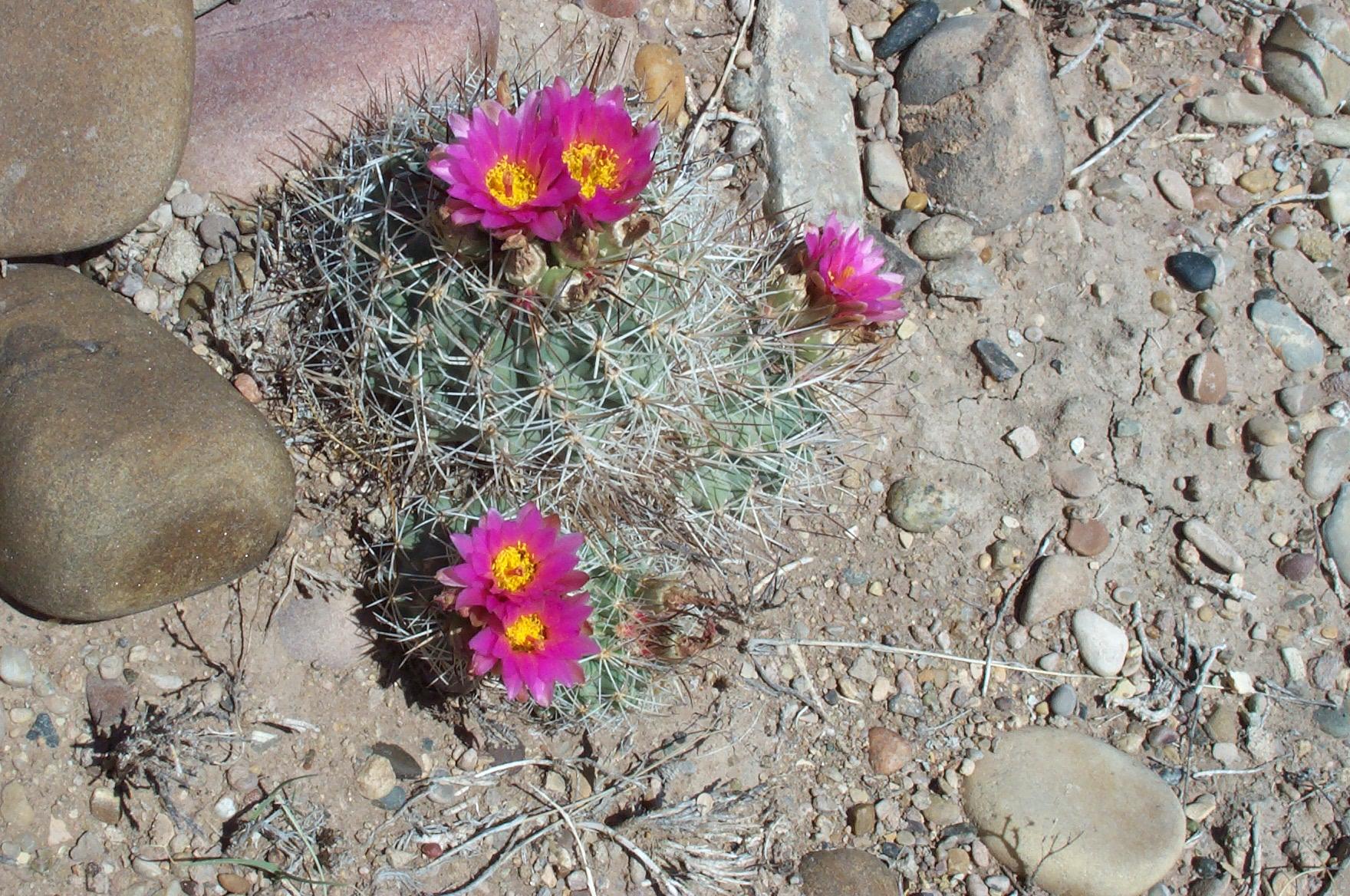Sclerocactus
|
Family: Cactaceae |
Plants erect, usually unbranched, sometimes deep-seated in substrate in winter but never flat-topped. Roots diffuse. Stems unsegmented, pale to dark green or bluish green, ovoid, spheric, depressed-spheric, depressed hemispheric, cylindric, or elongate cylindric, 1-40(-45) × 1.8-15(-20) cm, occasionally glaucous; tubercles usually coalescent into ribs (rarely remaining as separate tubercles); ribs 10-17(-20), crests deeply notched above each areole, thus ribs tuberculate; tubercles ± prominent on ribs; areoles 8-20 mm apart, elliptic to pyriform, with fertile portion as short adaxial prolongation confluent with spine cluster or connected to spine cluster by very broad groove, woolly; areolar glands few or absent; cortex and pith highly mucilaginous. Spines 2-17(-29); radial spines 2-11(-18) per areole, usually white or gray, sometimes straw colored, brown, pink, purplish pink, or black, straight or curved; central spines (0-)1-6(-11) per areole, gray, white, yellow, straw colored, red, reddish brown, brown, pink to purplish pink or black, usually of 2-3 distinct types, 1 or more hooked (rarely none hooked), acicular or subulate, or both (ribbonlike and papery in S. papyracanthus), longest spines 7-15 mm. Flowers diurnal, borne at adaxial edge of areoles at or near stem apex or in short extension of spine-bearing areoles, campanulate or funnelform, 1-6.7 × 1-6(-7) cm; outer tepals with greenish lavender, reddish brown, yellowish brown, or purple midstripes, white, cream, gold, rose, pink, or purple margins, oblanceolate, 10-45 × 3-10 mm, margins entire or fimbriate; inner tepals erect to ascending white, cream, yellow, or pink to purplish, often with dark midstripes, lanceolate to oblanceolate, 15-50 × 4-12 mm, margins entire or fimbriate; ovary scaly, spineless; stigma lobes 5-12, pink, green, yellow, or creamy white, 1.5-3.5 mm. Fruits dehiscent along 2-4 irregular, short vertical slits above base, or through basal abscission pore, green, often turning tan, pink or red, cylindric to subspheric, 4.2-30 × 3.5-21(-25) mm, thin walled, fleshy, becoming dry at maturity, naked or with few broad, thin scales; pulp greenish to white, scant; floral remnant persistent. Seeds brown or black, 1.5-3 × 1.9-4.5 mm, glossy or shiny; testa papillate (rarely furrowed). x = 11. There has been considerable controversy concerning generic circumscription of Sclerocactus. Some treatments include Ancistrocactus, Echinomastus, Glandulicactus, and Sclerocactus as a single genus; whereas others exclude those groups, in addition to Toumeya, from Sclerocactus. Molecular phylogenetic studies of chloroplast DNA sequences (J. M. Porter et al. 2000; R. Nyffeler 2002) support a close relationship among Ancistrocactus, Echinomastus, Toumeya, and Sclerocactus; only Toumeya is included with Sclerocactus here. Although morphologically cohesive, Echinomastus is inferred to be a paraphyletic group, with some species (i.e., E. johnsonii) more closely related to Sclerocactus than to other members of Echinomastus. Ancistrocactus is sister to Echinomastus and Sclerocactus, providing merit to a broader circumscription of Sclerocactus. Glandulicactus and Pediocactus are only distantly related to this group, bolstering their exclusion from Sclerocactus.
PLANT: Small barrel-shaped stem-succulents from freely branching primary and secondary roots. STEMS: mostly solitary, occasionally clumped, ovoid, globose, hemispheric to elongate-cylindrical, 3.5-13 cm in diameter, 3-27 cm tall, pale green to dark green or bluish green. AREOLES: elliptic. SPINES: 7-23, usually of two or three distinct types and usually one or more hooked, the longer ones 1.2-7.2 cm long, 0.7-3 mm wide, acicular or subulate or commonly some of each type, gray, white, yellow, straw-yellow, red, reddish-brown, brown, pink to purplish-pink or black. FLOWERS: near apex of stem, opening 1.5-5.5 cm wide, 2.2-5.7 cm long; floral tube funnelform; bracteoles soft and scale-like, succulent, the margins hyaline, entire or fimbriate, the axils naked or sparsely hairy; outer tepals , oblanceolate, 2-4 cm long, 4-8 mm wide, with greenish-lavender, yellowish-brown, or purple midstripes, the margins white, cream, gold, rose, pink, or purple; inner tepals lanceolate to oblanceolate, 2-4 cm long, 5-10 mm wide, white, yellow, or pink to purple, magenta or lavender; filaments white, cream, green, pale yellow, purple or magenta, the anthers yellow; style cream, light green, pink or purple; stigma 7-10 lobed, green to yellowish-green; ovary with large papillae and appearing granular, or with small papillae and appearing smooth. FRUITS: thin-walled, cylindrical, 0.8-2.5 cm long, 0.6-1.5 cm wide, green, often turning red, naked or with a few broad, thin scales, drying at maturity and opening with 2-4 irregular short, vertical slits above the base, or indehiscent. SEEDS: 1.5-3 mm long, 2-3.5 mm in diameter, 1-1.5 mm thick, dark brown or black, papillate, furrowed. NOTES: Species 13, in the sw U. S. Circumscription of genus is debated: here to include Coloradoa Boissevain & Davidson and Toumeya Britt. & J. N. Rose, but distinct from Ancistrocactus Britt. & J. N. Rose, Echinomastus Britt. & J. N. Rose, Glandulicactus Backeb., Homalocephala Britt. & J. N. Rose and Pediocactus Britt. & J. N. Rose. (Greek: sclero = hard or cruel, referring to the spines + kaktos = a spiny plant). Heil, K. H. and J. M. Porter. 1994. Haseltonia 2:20-46. REFERENCES: Heil, Kenneth D., and Mark J. Porter. 2001. Cactaceae. J. Ariz. - Nev. Acad. Sci. Volume 33(1). |

